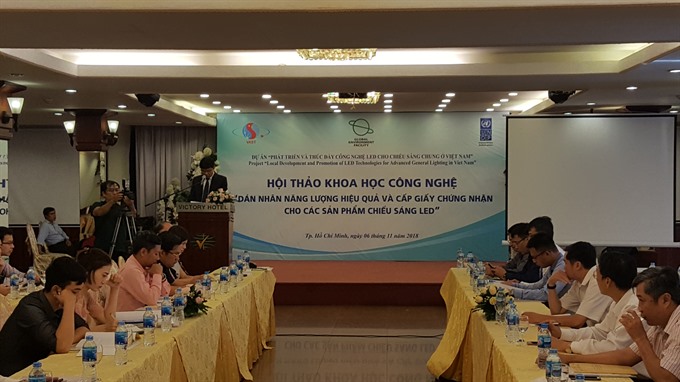 Society
Society

The adoption of minimum energy performance standards will achieve a minimum saving of around VNĐ10 trillion (US$480 million) and a reduction of 34 million tonnes of CO2 emissions by 2030, a workshop heard in HCM City yesterday.
 |
| The “Energy Labelling and Certification for LED lighting products” workshop opens in HCM City on Tuesday. -- VNS Photo Hoàng Nam |
HCM City – The adoption of minimum energy performance standards will achieve a minimum saving of around VNĐ10 trillion (US$480 million) and a reduction of 34 million tonnes of CO2 emissions by 2030, a workshop heard in HCM City yesterday.
Nguyễn Văn Thao, general director of the Việt Nam Academy of Science and Technology’s High Technology Development Center told the “Energy Labelling and Certification for LED lighting products” workshop: “The electricity saving will be about 6,000 GWh per year, equivalent to the electricity generated by two coal-fired power plants with a capacity of 500 MW.”
This was the right time to implement the energy-labelling programme for LED lighting products, he said.
United Nations Development Program (UNDP) expert My Ton emphasised the need to obtain sufficient market data to identify appropriate parameters and characteristics such as efficacy, lifetime and rendering index for LED labelling suitable for both large and small manufacturers and importers.
At the same time, raising awareness and providing consumers with necessary information on LED labelling was also important, contributing to effective implementation of the energy labelling programme and keeping low-quality LED products out of the market, he added.
LED bulbs have a lifetime of 25,000-50,000 hours and can save electricity use by 50-70 per cent.
This workshop was held as part of a project called “Local Development and Promotion of LED Technologies for Advanced General Lighting in Việt Nam” (LED) supported by the Global Environment Facility and the UNDP.
This was the 3rd workshop in the energy labelling program and sought to introduce, guide and discuss regulations for compulsory labelling of LED lighting products from January 1, 2020.
The LED project has the goal of reducing greenhouse gas (GHG) emissions by transforming the lighting market in Việt Nam.
The project has helped Việt Nam develop LED technologies and market through developing TCVN standards for LED lamps, directly supporting two light producers in improving design, production process and product quality and demonstrating and installing their LED indoor and street lighting products.
It is expected the project will contribute to direct GHG emissions reduction of 69.38 kilotonnes of CO2 by 2020 and 5,154 kilotonnes by 2030.
Potential indirect GHG emissions are estimated at just 5,154 kilotonnes of CO2 over 10 years from the end of the project.
Participating in the workshop were representatives from Ministry of Indsutry and Trade, the Việt Nam Lighting Association, the Standard Institution, VAST, lighting experts, and LED manufacturers and importers, service providers, and consumers from the south. – VNS